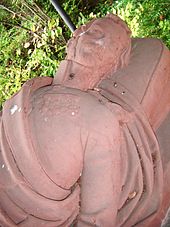Georg von Mölter
Georg Mölter , knight of Mölter since 1815 (born August 5, 1775 in Bastheim , † October 25, 1846 in Landau ) was a Bavarian major general .
Life
family
He was the son of the Prince-Bishop of Würzburg Captain Adam Mölter. His older brother Joseph Mölter (* 1773) was a Catholic priest and pastor in Schweinfurt and Eltmann .
Military career
Mölter entered the military service of the Würzburg bishopric in 1795 and was taken over in the Bavarian canton of Bavaria in 1803 after secularization . In 1807 Mölter was promoted to first lieutenant . In 1812 he fought with the Bavarian contingent on the side of Napoleon in Russia. He stood out against the French in the battle of Hanau in 1813 , as well as in La Rothière on February 1, 1814, for which Georg Mölter received the Knight's Cross of the Military Max Joseph Order in 1815 . Associated with this was the elevation to the personal nobility and he was allowed to call himself Ritter von Mölter after his entry in the nobility register . He was also a member of the French Legion of Honor and Knight II Class of the Russian Order of St. Anne .
From 1827 to 1837 Mölter acted as commander of the 5th Chevaulegers Regiment in Zweibrücken . In 1837 he was promoted to major general and took the position of commandant of the Landau fortress . Here he worked for nine years, died there and was buried according to the Catholic rite in the cemetery, where his ornate Tumba tomb with a reclining figure has been preserved. It comes from the Mannheim sculptor Wilhelm Hornberger , a graduate of the Academy of Fine Arts in Munich , a student of Bernhard Würschmitt and Ludwig Schwanthaler . Later he created a similar tomb for Mölter's successor Karl Freiherr von Pflimmern (1787–1850).
literature
- Jutta Franke: Mölter, Georg von. In: Karl Bosl (ed.): Bosls Bavarian biography. Pustet, Regensburg 1983, ISBN 3-7917-0792-2 , p. 530 ( digitized version ).
- Emil Buxbaum: The Royal Bavarian 3rd Chevaulegers Regiment "Herzog Maximilian" 1724 to 1884. Oldenbourg, 1884, p. 21 ff. ( Limited preview in the Google book search).
- Georg Gilardone: Mölter, Georg von. In: Anton Chroust , Sigmund Freiherr von Pölnitz (Hrsg.): CVs from Franconia. Volume 5, Duncker & Humblot, Berlin 1936, pp. 223–232 ( limited preview in the Google book search). In addition register entry in: Elisabeth Friedrich: (Ed.): Lebensbilder-Register. Neustadt / Aisch, Degener 1971, ISBN 3-7686-2001-8 , p. 89 ( limited preview in the Google book search).
Web links
- Entry in the portal thesaurus
- Website of the parish of Hl. Geist Schweinfurt, with a short biography of brother Josef Mölter
Individual evidence
- ↑ CVs from Franconia. Volume 5, 1936, p. 232. Excerpts from the source
- ^ Website on the battle of Hanau, with the mention of Mölter (under October 30, 1813) ( Memento from March 2, 2006 in the Internet Archive )
- ^ Emil Buxbaum: The Royal Bavarian 3rd Chevaulegers Regiment "Herzog Maximilian" 1724 to 1884. pp. 20-21. Excerpt from the source
- ^ Scan from the State Handbook of the Kingdom of Bavaria 1833
- ↑ Court and State Handbook of the Kingdom of Bavaria 1833. p. 165.
- ^ Herrmann Julius Meyer: New conversation lexicon. Volume 9, 1865, p. 98.Scan from the source
| personal data | |
|---|---|
| SURNAME | Mölter, Georg von |
| ALTERNATIVE NAMES | Mölter, Georg Ritter von; Mölter, Georg |
| BRIEF DESCRIPTION | Bavarian Major General, Knight of the Max Joseph Order |
| DATE OF BIRTH | August 5, 1775 |
| PLACE OF BIRTH | Bastheim |
| DATE OF DEATH | October 25, 1846 |
| Place of death | Landau in the Palatinate |

